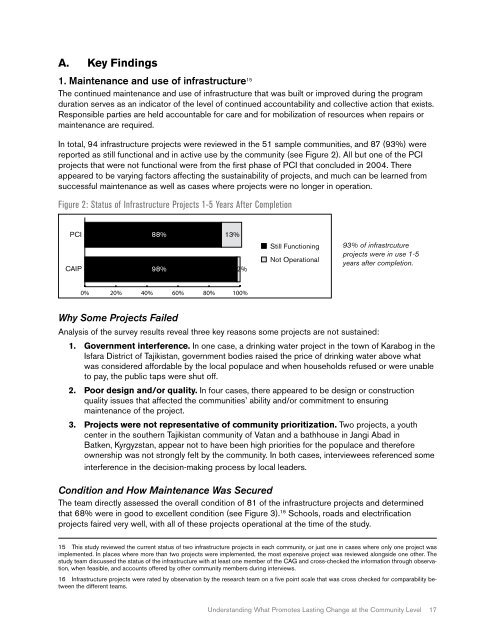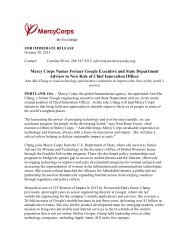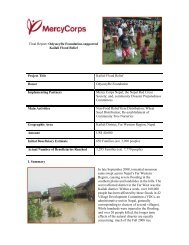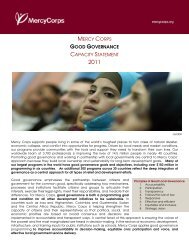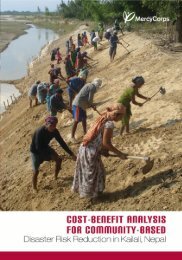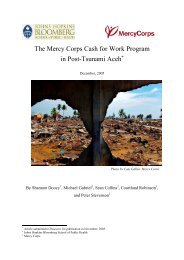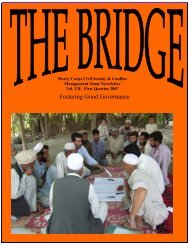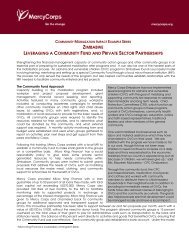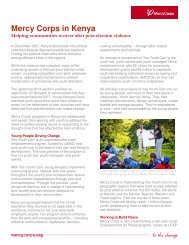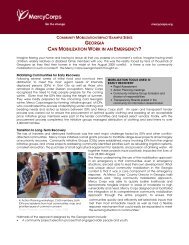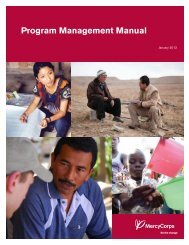SUSTAINABILITY FIELD STUDY - Mercy Corps
SUSTAINABILITY FIELD STUDY - Mercy Corps
SUSTAINABILITY FIELD STUDY - Mercy Corps
You also want an ePaper? Increase the reach of your titles
YUMPU automatically turns print PDFs into web optimized ePapers that Google loves.
A. Key Findings1. Maintenance and use of infrastructure 15The continued maintenance and use of infrastructure that was built or improved during the programduration serves as an indicator of the level of continued accountability and collective action that exists.Responsible parties are held accountable for care and for mobilization of resources when repairs ormaintenance are required.In total, 94 infrastructure projects were reviewed in the 51 sample communities, and 87 (93%) werereported as still functional and in active use by the community (see Figure 2). All but one of the PCIprojects that were not functional were from the first phase of PCI that concluded in 2004. Thereappeared to be varying factors affecting the sustainability of projects, and much can be learned fromsuccessful maintenance as well as cases where projects were no longer in operation.Figure 2: Status of Infrastructure Projects 1-5 Years After CompletionPCICAIP88%98%13%2%Still FunctioningNot Operational93% of infrastrcutureprojects were in use 1-5years after completion.0% 20% 40% 60% 80% 100%Why Some Projects Failed120Analysis of the survey results reveal three key reasons some projects are not sustained:1. Government interference. In one case, a drinking water project in the town of Karabog in theIsfara District of Tajikistan, government bodies raised the price of drinking water above whatwas considered affordable by the local populace and when households refused or were unableto pay, the public taps were shut off.2. Poor design and/or quality. In four cases, there appeared to be design or constructionquality issues that affected the communities’ ability and/or commitment to ensuringmaintenance of the project.3. Projects were not representative of community prioritization. Two projects, a youthcenter in the southern Tajikistan community of Vatan and a bathhouse in Jangi Abad inBatken, Kyrgyzstan, appear not to have been high priorities for the populace and thereforeownership was not strongly felt by the community. In both cases, interviewees referenced someinterference in the decision-making process by local leaders.Condition and How Maintenance Was SecuredThe team directly assessed the overall condition of 81 of the infrastructure projects and determinedthat 68% were in good to excellent condition (see Figure 3). 16 Schools, roads and electrificationprojects faired very well, with all of these projects operational at the time of the study.15 This study reviewed the current status of two infrastructure projects in each community, or just one in cases where only one project wasimplemented. In places where more than two projects were implemented, the most expensive project was reviewed alongside one other. Thestudy team discussed the status of the infrastructure with at least one member of the CAG and cross-checked the information through observation,when feasible, and accounts offered by other community members during interviews.16 Infrastructure projects were rated by observation by the research team on a five point scale that was cross checked for comparability betweenthe different teams.Understanding What Promotes Lasting Change at the Community Level17


